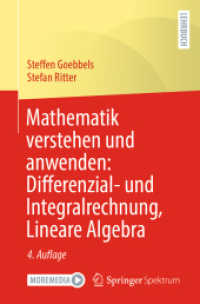- ホーム
- > 洋書
- > 英文書
- > Literature / Classics
Full Description
This volume publishes in full for the first time all known cuneiform manuscripts of an Akkadian calendar treatise that is unified by the theme of Babylonia's invasion. It was composed in the milieu of Marduk's Esagil temple in Babylon, probably in the Hellenistic period before c. 170 BC. Esagil rituals are presented as essential to protect Babylonia, and specifically Marduk's principal cult statue, from foreign attack. The treatise builds the case by drawing on traditional and late Babylonian cuneiform scholarship, including astronomy-astrology, accounts of warfare with Elam and Assyria, battle myths of Marduk and Ninurta, and wordplay. Calendrical sections contain an amalgam of apotropaic ritual against invasion, astrological omens of invasion as ritual triggers, past conflicts as historical precedent, divine combatants representing human foes, and sophisticated exegesis.
The work is partially preserved on damaged clay tablets in the British Museum's Babylonian collection and the volume presents hand-drawn cuneiform copies, a composite edition, and a manuscript score. A comprehensive contextualizing introduction provides readers in a range of fields - including Assyriology, classics and ancient history, ancient Iranian studies, Biblical studies, and ancient astronomy and astrology - with a key overview of topics in Mesopotamian scholarship, the manuscripts themselves, and their language and orthography. A detailed commentary explores how the treatise aims to demonstrate the critical importance of the traditional Esagil temple in Babylon for the security of Babylonia and its later imperial rulers.
Contents
Frontmatter
Bibliographical Abbreviations
Selected Conventions
INTRODUCTION
1. The calendar treatise and Mesopotamian scholarship
2. Topography: Babylonian cult and warfare
3. Manuscripts of the calendar treatise and the Mu%s=ezib family
4. Language and orthography
EDITION
Table of manuscripts
Previous publications
Calendar treatise: composite edition
MS A colophon and MS C vi: edition
Calendar treatise: manuscript score
COMMENTARY
§ 1 i 1-12: [Nisannu (day x)]
§ 2 i 1'-7': [Ayaru (day x)]
§ 3 i 8'-23': Sim=anu
§ 4 i 24'-35': Du'=uzu
§ 5 ii 1-3: [Du'=uzu] or [Abu (day x)]
§ 6 ii 1'-13': [Abu (day x)]
§ 7 ii 14'-iii 8: [Ul=ulu]
§ 8 iii 9-15: Ta%sr=itu day 6
§ 9 iii 16-26: Ta%sr=itu day 8
§ 10 iii 27-30: Ta%sr=itu day 13
§ 12 iii 1''-5'': [Kisl=imu (day x)]
§ 13 iv 1-41: .Teb=etu
§ 14 iv 1'-12': [Addaru (day x)]
Endmatter
References
General index
Selective index of texts and publications
CUNEIFORM TEXTS
Plates 1-8








